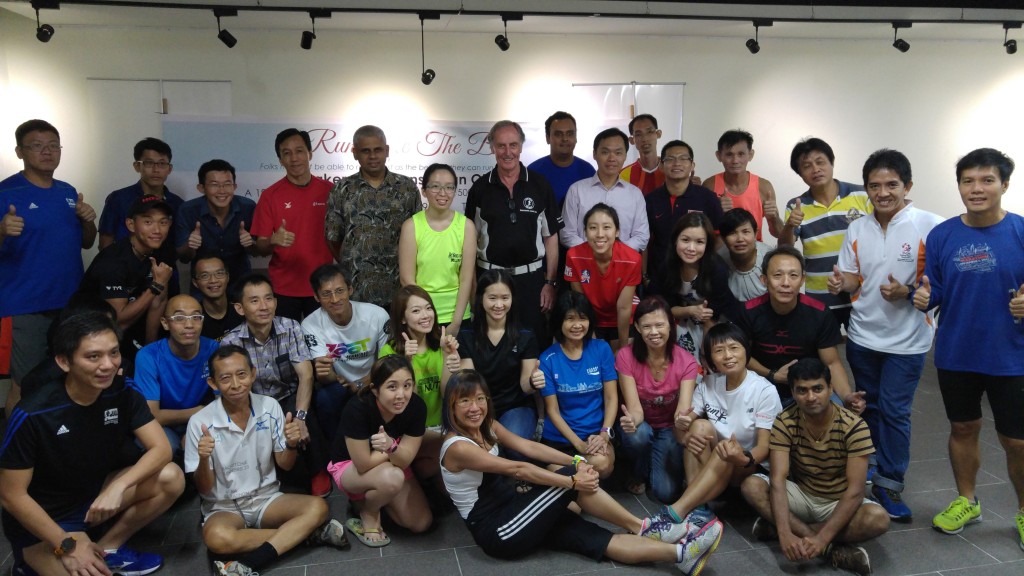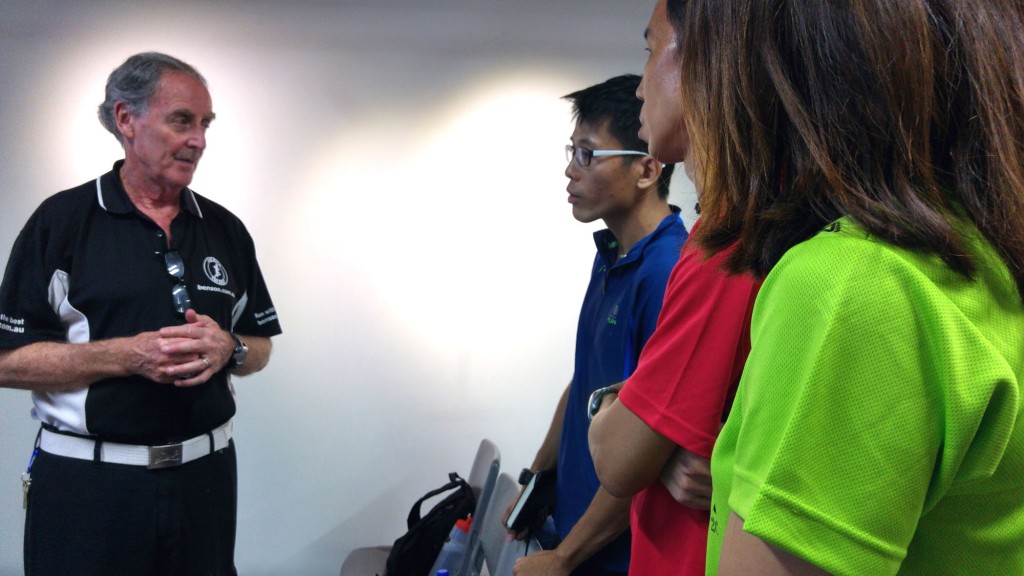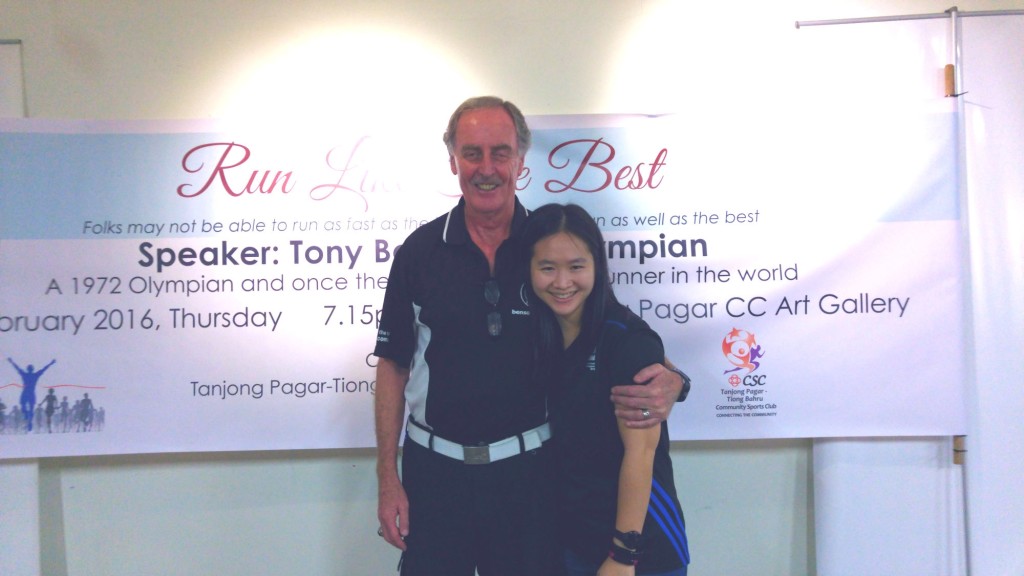Many people in the running circle have probably heard of Tony Benson.
Australian runner Benson, now 72, is a former Olympian – having participated in the 1972 Olympic Games, representing his country in the 5,000m distance. He was also a top-five runner in the world in 1971, for the 5,000m distance. And he recorded a 27:37-minute 10km run – the fastest in the world in 1971. As well he is also the last Australian runner to ever have won an IAAF Grand Prix 5000m race.
Benson was recently in Singapore to give a talk to runners at the Tanjong Pagar Community Club – and share some tips and secrets about running. Here are the main highlights of what he said.
Have Good Running Form
According to Benson, technique, endurance and speed are the three most important fundamentals for good running.
Said Benson, “Technique is not always necessary for a running world record, but it decides often, who will win in a sprint.”
In order to run, the body position should be tall and relaxed at the same time. The chest should be upright and you should not slouch forward as this would slow you down as a runner.
Added Benson, “One common mistake that people make is that they rotate their body – this causes their hips to move backwards when they are trying to move their feet forward. As such, the stride gets shorter. But if the hip stays down though, it can create a longer stride and you will run faster.”
He continued, “One thing about the arms too, is that they must help and not hinder your running. If you are able to literally pull yourself forward with just your arms, that is the secret to fast running.”
So in short, you should run with your arms at chest level, swinging them gently to propel you forward when you are running.As well, Benson also explained that runners should adopt a mid foot strike too. He explained, “For a forefoot striker, his heel never touches the ground but he gets a lot of calf problems. I have found that the faster runners seem to be mid foot strikers, from my experience. It is a way to improve stride length without compromising stride frequency.”
To reinforce these concepts, Benson did a practical demonstration with us, where we had to enact both good as well as bad running form and he would watch us doing so. I thought that this segment had been very useful.
Run most of your training sessions at a low heart rate zone
As well, Benson also pointed out during his talk, that elite athletes will go at a low to moderate effort for 70 to 80 per cent of their runs – that is how they are able to clock about 160kms to 200kms of mileage per week and at the same time to have enough time for recovery. Said Benson, “Their speed may look fast to us, but it is very easy to them.”
He continued, “On the other hand, most recreational runners are running at 80 per cent of their heart rate for the majority of the time. That leaves the body in an anaerobic state with insufficient oxygen.”
For example, Benson explains that if you run 10km in 50minutes, then you should aim to clock your easy runs at a 6.5mins/km pace. And if you run 60mins for 10km, then likewise, you should target a pace of 7.5mins/km for the majority of your runs.
Walking to build mileage at a low heart rate
Walking is also a good way to build mileage without stressing out the body, according to Benson. He explained, “All runners begin with walking. Target time instead of distance. Start with being outdoors for 1hour or 1.5hours but most of that will be walking and not running in order to keep the heart rate low.”
He continued, “Then over time as you get fitter and your heart gets stronger, gradually decrease the amount of time spent walking – sometimes you may find that you are going backwards and other times you may feel like resting, but at the end of your sessions you should feel a little sweaty but not exhausted. The only tired thing should be the leg muscles if you are not used to the exertion but those would go away over time. It is important to keep the maximum heart rate below 75 per cent of its capacity.”Benson feels many recreational runners today, are taking on running programmes found online, before they are prepared for it. According to him, you should be able to jog/walk 1.30hours once a week plus 1hour about three more times that week, before you can begin a fun runner’s programme.
Have a training programme customised to your own body
As such, Benson feels that it is important to adjust and customise your training to your own body. He explained, “Usually people who write training programmes and post them online, are those who are not very good in the first place.”
He continued, “You should be looking for advice from Olympic coaches – who are able to custom-make a programme used by elite athletes, to suit you. You need the very best advice from the beginning so that you can improve. If the advice is not high quality without a proven record, then you will not see any progress.”
Practise being on the road for the entire duration of your target race timing
For endurance runners, Benson also thinks that it is important to be out there for the full period that you are targeting for the race, but moving at a much slower pace, though. This applies to both the marathon as well as the half marathon distances.
He explained, “During races, it is much harder for the fun runner than an elite runner especially on a hot day. The elite runner, for example, will compete a marathon in two and a half hours and go home to sleep. But the fun runner will be out there for four or even five hours – that is twice the time.”As such, fun runners will need to practise being out there for that length of time. Said Benson, “If for example you target four hours for the marathon, you need to do three runs for a duration of more than four hours at a very easy heart rate effort – walking for the entire four hours is perfectly fine.”
He continued, “It will help you get a feeling of what it’s like to be out there for that long – and is also the only way that you can practise your fuelling strategy for that length of time and figure out how to keep stitches, etc, at bay. This also applies to the half marathon distance.”
A different approach to interval training
Benson also has a slightly different approach to interval training compared to most people. He said, “I do not believe that interval training helps you to become a better runner – unless you are taking part in a race that says to run 400m and have a rest for 30seconds, and then to repeat the cycle several times.”
He added, “But it is good to allow you to increase your speed to faster than what you are usually doing. So if you are doing interval training, you would do six sets of the 400m track and do not care about the recovery. You want to complete the entire interval session in a faster time overall. After the first 400m, you will recover faster than the second 400m set. You will require a longer rest after the second set, and do not worry about that.”
Continued Benson, “To me, interval training is all about learning to run at higher speed on race day, so this type of running will help you to build a bigger engine and run faster timings – compared to the standard interval training that has fixed rest periods. I call it repetition runs.”


![Running form and technique is very important according to Benson. [Photo from isabellafitness.com]](https://www.prischew.com/wp-content/uploads/Running-Form-.jpeg)

![Walking is a good way to build mileage. [Photo from www.huffingtonpost.com]](https://www.prischew.com/wp-content/uploads/o-15-MINUTE-WALK-BLOOD-SUGAR-facebook-1024x682.jpg)
![Practise being outdoors for the entire duration of your target race timing. [Photo by Amanda Mills]](https://www.prischew.com/wp-content/uploads/15322-a-healthy-young-woman-running-outdoors-on-a-track-pv-639x1024.jpg)

Hi Tony. You were one of our Teachers at St Pats Ballarat in the late 1960’s and 1979’s. I’m Noel Sheehan and hoping this message gets to you. Peter Crawford was also one of your students both in class and in Athletics. Peter is turning 70 on the 28th Oct. One of his daughters is organising a surprise online surprise party. I have reconnected with a Peter in recent years and he relates stories of his time at SPC and has often spoken of you fondly and with respect and admiration. Could you respond to me at noel@stafforgserv.com.au or 0418509809. I am sure Peter would be thrilled to receive a birthday wish from you.
Hi Tony, my name is Noel Sheehan, a student of yours when you were teaching at St Pats Ballarat in the late 1960’s early 1970’s. Peter Crawford, I am sure you will remember was a very good runner whom you coached. One of Peter’s daughters is organising a surprise on-line 70th birthday surprise for him. I have reconnected with Peter in recent years and have enjoyed many chats. Peter has very fond and respectful memories of you as a person, teacher and coach. I thought I would try to contact you to see if you would like to send a video message to Peter for his 70th. I know he would be absolutely thrilled. I have no idea where you live now but am hoping this message gets through to you. Could you contact me at noel@stafforgserv.com.au or you are most welcome to contact me at 0418 509 809.